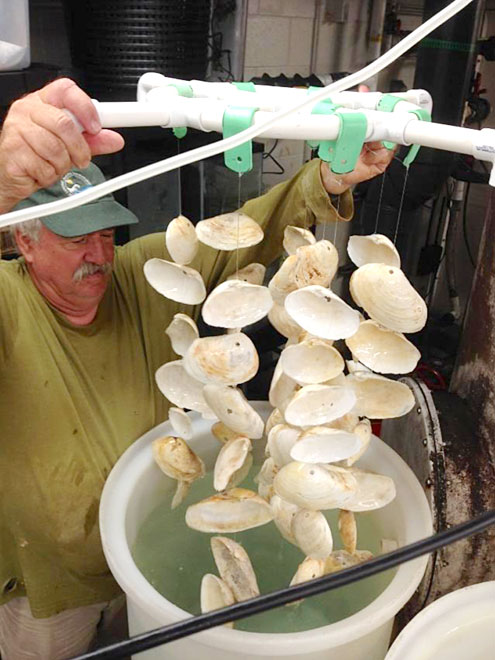
MLML Aquaculture Specialist Peter Hain holding shell “mobile” he designed to deploy settlement substrates in the tank holding oyster larvae. • Photo Credit: Dan Goassard, MLML
On October 23, 2018, a new generation of Olympia oysters settled into their home on the tidal mudflats of the Elkhorn Slough National Estuarine Research Reserve. These oyster babies were raised at Moss Landing Marine Laboratories’ new Aquaculture Facility, with a grant from the Anthropocene Institute and support from California Sea Grant. This effort represents the first attempt to support native oyster restoration through aquaculture in the state of California.
Elkhorn Slough’s native oyster population is at real risk of disappearing entirely. Native American middens and paleo-ecological data reveal oysters have lived in the estuary for ten thousand years.
Elkhorn Slough Reserve’s Research Coordinator, Dr. Kerstin Wasson explains: “In all the years I’ve been monitoring, we only had a good crop of new juveniles appear twice, once in 2007 and once in 2012,” says Dr. Wasson.
For the past decade, the Elkhorn Slough Reserve and Elkhorn Slough Foundation have been committed to conservation of the native Olympia oyster in Elkhorn Slough. Their goal is to ensure that this iconic bivalve thrives in this estuary as a legacy for future generations.
Elkhorn Slough Reserve volunteers Ken Pollak and Celeste Stanik deploying clam shell reefs with oyster restoration expert Chela Zabin. • Photo Credit: Kerstin Wasson, Elkhorn Slough Reserve
In 2012, Dr. Wasson, along with Elkhorn Slough Reserve Biologist Susie Fork and the Smithsonian Environmental Research Center’s Dr. Chela Zabin, deployed hundreds of clamshell reefs to provide habitat to native oysters, which need hard substrate that prevents them from being buried in the mud. Since then, however, virtually no new recruits have appeared on these reefs or anywhere in the estuary.
Estuaries with high failure rates tended to have small remaining oyster populations and strong marine influence resulting in cold waters and larvae being swept out to sea rather than retained in the bay. One solution was to raise native oyster spat in a hatchery, the way commercially grown, non-native oysters are produced because waters are generally too cold for natural reproduction.
Moss Landing Marine Laboratories (MLML) Dr. Wasson and her former student Dr. Brent Hughes, now a professor at Sonoma State University, received a grant from the Anthropocene Institute to fund the aquaculture project.
After larvae release from the female oysters, free swimming larvae were moved to separate rearing tanks until they were large enough, with eyespots and a mobile foot, to begin settling on native gaper clam shells as a settlement surface.
“Raising oysters is a finicky business but we got them through,” says California Sea Grant Aquaculture Specialist and MLML Research Faculty member Luke Gardner.
Finally, about 2,500 fresh oyster recruits are ready for the real world – about 10 times the number of live oysters in the part of the Elkhorn Slough Reserve where they will be transplanted.
On October 23, a team of Elkhorn Slough Reserve staff and volunteers attached clam shells bearing newly settled oysters to wooden stakes, and put these out in the mudflats of the Reserve. Past data suggests that oysters, once settled, grow and survive quite well.
“Linking oyster restoration to aquaculture may be the answer to saving this species in Elkhorn Slough and other highly altered estuaries,” says Reserve Manager Dave Feliz, who manages Elkhorn Slough National Estuarine Research Reserve for the California Department of Fish and Wildlife (CDFW), which owns the property.